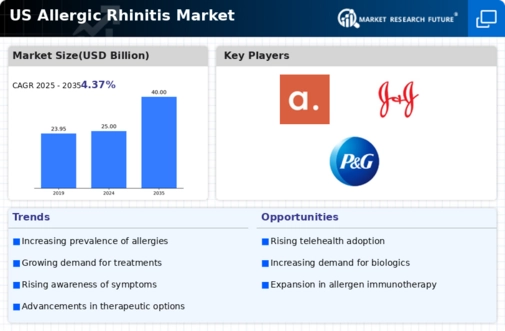Rising Healthcare Expenditure
The allergic rhinitis market is positively impacted by the rising healthcare expenditure in the US. With healthcare spending projected to reach approximately $4.3 trillion by 2025, there is a growing investment in allergy-related treatments and services. This increase in expenditure allows for better access to medications, diagnostic tools, and healthcare services for patients suffering from allergic rhinitis. Moreover, as insurance coverage expands and more individuals seek treatment, the market is likely to see a surge in demand for both prescription and over-the-counter products. The financial commitment to healthcare not only enhances patient access but also encourages pharmaceutical companies to invest in research and development, ultimately benefiting the allergic rhinitis market.
Advancements in Pharmaceutical Research
Innovations in pharmaceutical research are significantly influencing the allergic rhinitis market. The development of new drug formulations and delivery systems, such as sublingual immunotherapy and monoclonal antibodies, is providing patients with more effective treatment options. For instance, the introduction of biologics has shown promise in treating moderate to severe allergic rhinitis, potentially transforming patient management. The market is projected to witness a compound annual growth rate (CAGR) of around 5.2% over the next few years, driven by these advancements. Additionally, ongoing clinical trials and research initiatives are likely to yield new therapies, further enhancing the treatment landscape. As healthcare providers adopt these innovative solutions, the allergic rhinitis market is expected to benefit from increased patient adherence and satisfaction.
Growing Demand for Preventive Healthcare
The allergic rhinitis market is benefiting from the growing demand for preventive healthcare measures. As individuals become more health-conscious, there is an increasing focus on preventing allergic reactions before they occur. This trend is leading to a rise in the use of preventive medications, such as intranasal corticosteroids and antihistamines, which are designed to manage symptoms proactively. Furthermore, educational campaigns promoting awareness about allergy management are likely to encourage individuals to seek preventive care. The market is expected to see a shift towards more proactive treatment approaches, which could enhance patient outcomes and satisfaction. This growing emphasis on prevention is poised to play a crucial role in shaping the future of the allergic rhinitis market.
Increasing Prevalence of Allergic Rhinitis
The allergic rhinitis market is experiencing growth due to the rising prevalence of this condition among the population. Recent estimates indicate that approximately 19.1 million adults in the US are diagnosed with this condition, which translates to about 7.7% of the adult population. This increasing incidence is likely to drive demand for various treatment options, including antihistamines and nasal corticosteroids. As more individuals seek relief from symptoms such as sneezing, nasal congestion, and itchy eyes, the market is expected to expand. Furthermore, the growing awareness of the condition's impact on quality of life may lead to increased healthcare consultations, further propelling the allergic rhinitis market. The combination of a larger patient base and heightened awareness creates a favorable environment for market growth.
Impact of Climate Change on Allergen Exposure
This market is influenced by the impact of climate change on allergen exposure. As temperatures rise and weather patterns shift, the prevalence and distribution of allergens such as pollen are changing. For instance, studies suggest that longer growing seasons and increased carbon dioxide levels may lead to higher pollen counts, exacerbating allergic rhinitis symptoms for many individuals. This environmental shift is likely to increase the number of people seeking treatment, thereby expanding the allergic rhinitis market. Additionally, public health initiatives aimed at educating individuals about managing symptoms in response to changing environmental conditions may further drive market growth. The interplay between climate change and allergen exposure presents both challenges and opportunities for the allergic rhinitis market.

















Leave a Comment